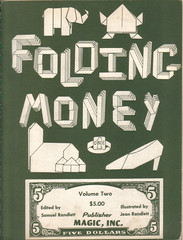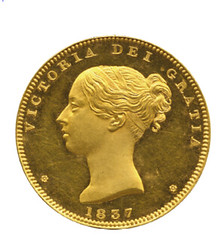
PREV ARTICLE
NEXT ARTICLE
FULL ISSUE
PREV FULL ISSUE
NOTES FROM E-SYLUM READERS: MAY 20, 2012 On Looking Truly Remarkable Jim Charlton, an Ontario Numismatic Association founding member, attended the ONA convention last weekend. He is in great shape for a 100 year old. I am pictured on his left.
If you are indeed 'pictured on his left' then you must be the fellow in the beige jacket and the fellow in the blue tee-shirt must be the 100 year-old Jim Charlton! If that is indeed the case you look truly remarkable FOR YOUR AGE!!! To read the earlier E-Sylum article, see: CENTENARIAN JIM CHARLTON ATTENDS ONTARIO CONVENTION (www.coinbooks.org/esylum_v15n20a06.html) Issued vs. Unissued Obsolete Bank Notes Regarding the Circulated vs. Unc question, 99.9% of old-time collectors of obsolete bank notes issued by state-chartered banks 1782-1866 strongly prefer signed and issued notes, generally available in worn grades from very low to VF or EF to owning Uncirculated never-issued notes. To read the earlier E-Sylum article, see: ON HIGH CONDITION VS ACTUAL USAGE (www.coinbooks.org/esylum_v15n20a10.html) It Takes a Scholar To Tell You What's Not on Google Regarding books on the Internet - any monkey can type a search term into Google, but it takes a scholar to tell you what's *not* on Google!
Indeed. Bruce W. Smith's comments were spot-on. Yes, there's a ton of information out there now, but it is still just the tip of the iceberg of what exists in print and offline. I'm not giving up my library!
-Editor
To read the earlier E-Sylum article, see: MORE ON ELECTRONIC BOOKS (www.coinbooks.org/esylum_v15n20a09.html) On the Franklin Parisian Masonic Lodge Medal The Franklin piece in Baldwin's brought 5000 Pounds. Baldwin's have moved up to a 20% buyer's fee, so 5000 Pounds hammer is just about $10,000, a Ford-like price. I should certainly think it is a masonic jeton, rather than a medal, and it may appear in French catalogs of the series. Can't say I have looked, never having had to catalog this very rare item.

Michel Prieur forwarded a link to a listing of one of these, which has a good deal of information in French. See: www.cgb.fr/monnaies/vso/v11/fr/monnaiesad01.html It is cataloged as a jeton. To read the earlier E-Sylum article, see: QUERY: FRANKLIN PARISIAN MASONIC LODGE MEDAL INFORMATION SOUGHT (www.coinbooks.org/esylum_v15n20a23.html) More on Counterfeit-Detecting Marking Pens Didn't we go over "..the Usefulness of Counterfeit-Detecting Marking Pens" several times before? The pens use an ink containing iodine, which turns dark/black when exposed to starch. Because starch is used in most if not all wood-based papers, any counterfeits made using this paper will be detected using one of these pins. However, higher quality counterfeits using cotton or linen fibers may bypass such detection. One could make real currency appear to be fake by soaking it with water that contains starch, but it might not be one of those experiments that should be carried out in a public forum. Even though the Secret Service doesn't seem to care too much about numismatic coin forgeries, I believe they become quite excited about currency reproductions! To read the earlier E-Sylum article, see: MAN ARRESTED FOR CARRYING A REAL $50 BILL (www.coinbooks.org/esylum_v15n19a28.html) A Book on How to Fold Money
Also, I have three of those shirts made from folded money. My aunt, Doris Irizarry, learned to make them and gave them to me years ago. You will also note that my shirts each have a necktie, whereas the previous one you pictured did not.

To read the earlier E-Sylum article, see: NOTES FROM E-SYLUM READERS: MAY 13, 2012: A Folded Banknote Shirt (www.coinbooks.org/esylum_v15n20a13.html) On Family Dynasty Numismatic Firms
Jim Duncan of New Zealand writes: I would not have included Seaby's, as sadly they are no more, but I WOULD have included Baldwin's, where there is still a Baldwin working. To read the earlier E-Sylum article, see: (www.coinbooks.org/esylum_v15n20a08.html) More on Jewish Use of the Hexagram Below is a little more information to predate Jewish use of the hexagram that was mentioned is the last issue: Concerning the hexagram/Star of David/Seal of Solomon etc., there are earlier Jewish numismatic connections with the symbol than listed last week. In the German State of Brandenburg two Jewish mintmasters used this as their mark on coins from 1565 to1591. The same is true for a 15 kreutzer coin from Moravia dated 1659. It was also used in the Netherlands on a burial pass token for Jewish funerals to leave Amsterdam around 1670. But there were also many other, non-Jewish uses of the symbol over the years, from a good luck charm to an alchemical symbol to Masonic use etc. Many areas used the symbol. Ancient India was mentioned; many Islamic dynasties including the Ottomans used it, as well as the Franks (600-700 A.D.), medieval European states, Trebizond (Byzantine), Indian states, Nepal, U.S. Civil War tokens, Nigeria, and the Fulani and Hausa tribes of Africa. To read the earlier E-Sylum article, see: MORE ON HAYM SOLOMON (www.coinbooks.org/esylum_v15n20a15.html) U.S. Treasury Building Exhibit on U.S. Mints Some time ago I promised to send a comment regarding locations where the U.S. Mint struck items. In the early/mid 1970s, there was an exhibit in the U.S. Treasury Building displaying activities of the many Treasury functions and agencies. This exhibit was accessible to the public by an entrance at/under the building's West entrance steps (facing the White House grounds and visitor entrance). The exhibit included activities of the U.S. Mints and had a coining press that was used strike a commemorative medal for anyone on demand, upon purchasing a blank bronze planchet ($3, I believe). That exhibit is long gone. Bentley Collection Sale Results

Lot 3, a George III 1817 Proof Sovereign drew a great deal of pre-sale interest, not least because the modern milled gold Sovereign was introduced to the British public on the 5 July 1817. The standard design for the initial currency depicts King George III on the obverse and carries the first depiction of the classic St. George slaying the dragon design on the reverse. The design, engraved by the famous medallist Benedetto Pistrucci, has now become an iconic image and synonymous with the Sovereign. One of the key features of the design of this proof, as adopted and engraved for currency by Pistrucci, are the wreath of 10 leaves and the date below the bust, coupled of course with St George slaying the dragon. Some of the letters in the legend lack serifs no doubt due to blockages or faulty letter punches with corner serifs broken off being employed. The lot sold for £27,600 but carried an estimate of £15,000 - 20,000.
Parts two and three of the Bentley Collection are due to be sold on the 27th September 2012 and the beginning of May 2013. The collection, in its entirety, is estimated to achieve around £3,000,000 and the decision to divide the collection in to three parts has been carefully considered to allow Sovereign collectors time to plan their proposed purchases properly. For more information, see: www.baldwin.co.uk/bentley
To read the earlier E-Sylum article, see:
THE BENTLEY COLLECTION OF BRITISH GOLD SOVEREIGNS
(www.coinbooks.org/esylum_v15n13a12.html)
The Numismatic Bibliomania Society is a non-profit organization promoting numismatic literature. See our web site at coinbooks.org. To submit items for publication in The E-Sylum, write to the Editor at this address: whomren@gmail.com To subscribe go to: https://my.binhost.com/lists/listinfo/esylum All Rights Reserved. NBS Home Page Contact the NBS webmaster 
|


